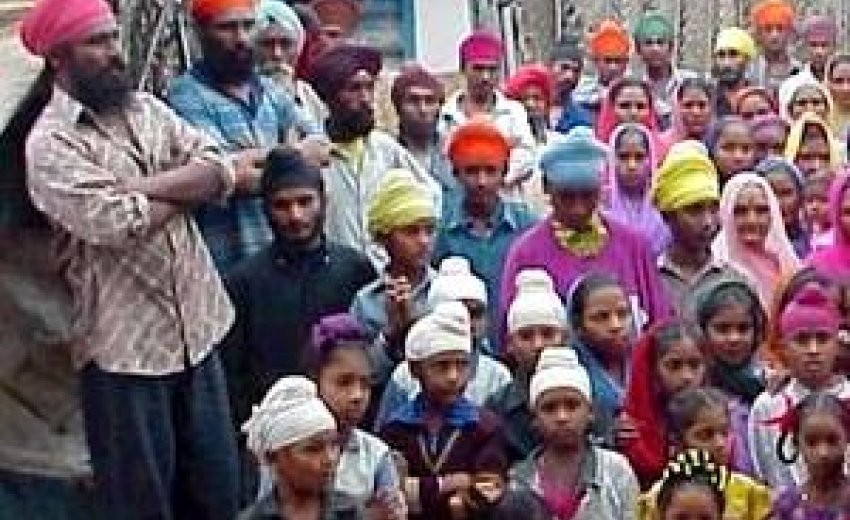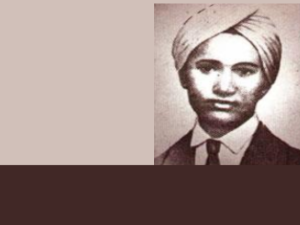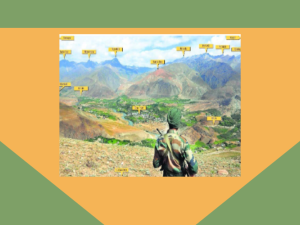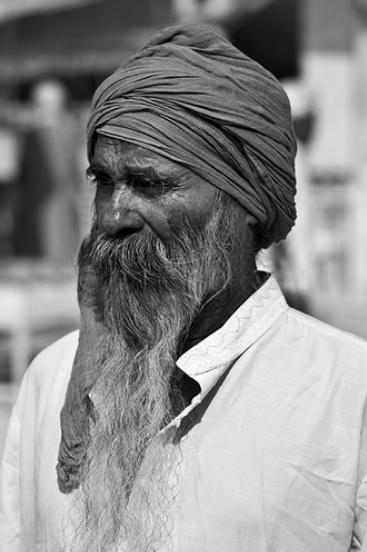 Sikligars Sikhs were the lohars (ironsmiths/blacksmiths) who once specialized in the craft of making and polishing weapons.
Sikligars Sikhs were the lohars (ironsmiths/blacksmiths) who once specialized in the craft of making and polishing weapons.
- Population in this Country: 5 million
- Country: India
- Continent: Asia
- Region: South & Central India
- People Name: Sikligar Sikh
- Alternate People Names: Kamgar, Karinagar, Kuchband, Lohar, Panchal Saiqalgar, Saqqa, Siqligar, Siqligar Sikh
- Social Status: Dalit
Sikligars Sikhs were the lohars (ironsmiths/blacksmiths) who once specialized in the craft of making and polishing weapons.
Once more commonly known as Gaddilohars the term Sikligar was bestowed on these men who fashioned iron by Guru Gobind Singh who turned Lohgarh (the Iron fort at Anandpur Sahib) into the Sikh Armoury. The word is derived from the Persian - saqi/sakli, lit. polishing, furnishing, making bright (a sword), the term saqlgar means a polisher of swords.
In medieval India, Sikligars were in great demand for manufacturing spears, swords, shields and arrows. What the world knows as Damascus steel, used in making some of the finest swords known to man, was manufactured by Indian lohars and shipped to Damacus as layered iron pellets.
Recently a piece of Gold embellished steel armour decorated with Sikh Bani (Hinted to be possibly once owned by Guru Gobind Singh) was made of this type of steel, which in India was called watered steel as its surface reminds one of flowing water. A lohar by the name of Ram Chand, initiated as a Sikh by Guru Gobind Singh, became Ram Singh the first Sikligar Sikh. Though not one of the Panj Piares he was with the Panj Piaras and Guru Gobind Singh fighting in the battle of Chamkaur and accompanied the Guru out of the fort in the night.
Traditionally held to be of a low caste (working with iron can make one appear very dirty) the gaddilohars first came in contact with Sikhi during the time of Guru Hargobind (1595-1644) who had, after the Martrydom of his father Guru Arjan initiated the 'practice of arms' and 'statehood' among Sikhs with his donning of 'Miri and Piri' (his two swords which sybolized spiritual and wordly power). They seem to have been Rajputs of Mewar who came to the aid of Guru Hargobind who percieved the need for his Sikhs to begin to learn and master the martial arts to insure their growing community's survival.
Today
The advent of modern weapons and industrial technology has hit the Sikligars hard economically. Engaged in the pursuit of an obsolete occupation, they are now a poor and backward people forming one of the scheduled castes as defined under the Indian Constitution.
Also known as gaddilohars they roam about in small groups carrying their meagre possessions on specially designed carts (gaddi, in north Indian dialects) making and selling small articles such as knives, sickles, betel nut cutters, sieves, locks, buckets and toys which they often manufacture from waste metal. The influence of Sikhism is still clearly discernible in the dress and social customs of some of the Sikligars. The males, especially those of the older generation, wear their hair long. Their womenfolk wear salvar (loose trousers) and kamiz (shirt) like Punjabi women or lahinga (skirt) and choli (bodice) like Rajasthani women, but the use of dhoti and san is rare.
The Initiation of a Sikligar Child
The newly born child is, on its fourth day, administered Amrit by five Sikhs; relatives and friends assemble in Sangat where karah prasad is distributed. A special share of karah prasad is sent to any member who keeps the Guru Granth Sahib or any 'breviary of gurbam' at home. Sikligar Sikhs of Central and South India have great faith in Takht Sachkhand Sri Hazur Sahib at Nanded, which they visit regularly. On the annual Takht ishnan (lit. bathing ceremony) at the Takht Sahib, it is the special privilege of Sikligar Sikhs to clean and oil the old weapons preserved there as sacred relics. (1) 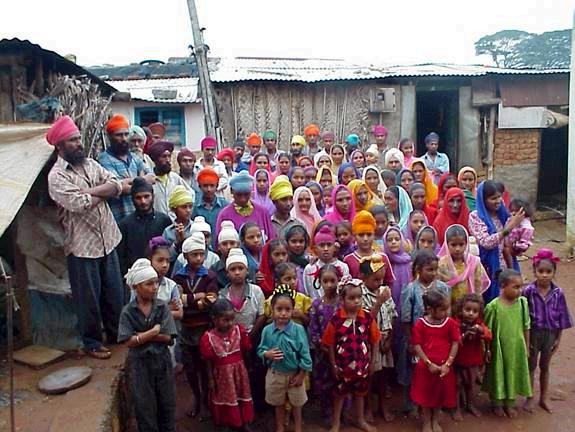 If we consider their dedication and commitment to Sikhism, this tribe ranks among its foremost practioners. Lacking any help from any quarter and living in penury they still remain in high spirits with a positive outlook on life. Their poverty however, has kept them beyond the attention of so called Sikh Sardars. Neither any Gurdwaras' Committees nor any worthwhile Sikh organization has paid any attention to or tried to give them 'a helping hand'.
If we consider their dedication and commitment to Sikhism, this tribe ranks among its foremost practioners. Lacking any help from any quarter and living in penury they still remain in high spirits with a positive outlook on life. Their poverty however, has kept them beyond the attention of so called Sikh Sardars. Neither any Gurdwaras' Committees nor any worthwhile Sikh organization has paid any attention to or tried to give them 'a helping hand'.
The days are far behind when Guru Hargobind Ji wore the swords of Meeri and Peeri to save the masses from the tyranny of Mughals; when he felt the need of arms he remembered these Marwar brothers. These were the same Marwari brothers whose chief Rana Partap was inspired by Sri Chand Ji the son of Guru Nanak, to sacrifice his every thing for religion. He fought the Mughals valiantly losing the battle of arms but not the battle of mind. They accepted the vagaries of forests but not the servitude of Mughals. They adopted the profession of manufacturers of arms and took it upon themselves to supply these to their fellow Sikhs in their fight for survival against their Mughal attackers.
On invitation from the Guru, they permanently became attached to the Guru Ghar. They not only manufactured the arms for the Gurughar, they also fought in many battles attaining martyrdom. When Gurujee sent Bhai Jetha and Bhai Bidhi Chand to look for artisans, Bhai Kehar Singh Rajput was the first one to offer his services. Men brought by him made weapons that were used by the Sixth and Tenth Gurus in all their battles with the Mughals and the Pahari Rajas. In between, during the period of non-violence when the need for weapons waned their occupation was affected adversely. The residents of Chittaurgarh did not behave well with their forelorn brothers and so they returned to Marwar. Marital relationships were formed within the tribes and tradition of exchange also began due to the needs of the times.
Some Sikligars associated with Guru Teg Bahadur also went with him to Assam and continued to supply weapons for royal armies. Their fate took a turn towards the positive when the Tenth Guru took over. He called upon his followers to bring weapons. Sikligars also contributed their mite. First of all came Bhai Veeru who provided the details of his brethern. The Guru asked him to exhibit weapons. He ordered Bhai Nand Singh and Bhai Chaupa Singh to check the exhibited weapons. Guru Sahib too paid a visit to the exhibition.
The weapons were extremely beautiful and shining brilliantly. These were so sharp that they would have severed the heads of elephants. The makers of these weapons themselves were such warriors that they could each fight alone with a lakh and quarter. Observing the shine of their weapons the Guru himself named them ‘Sikligar’ and after observing their valour bestowed them with the title of his favorites. The swords, arrows and other weapons made by them were adopted enthusiastically by the Guru.
Lohgarh becomes the Sikh Armory
The weapon manufacturing activity started in the fort of Lohgarh under the supervision of these Marwari artisans. According to Bhai Santokh Singh, “Marwaris were very active in making weapons.” They prepared four types of weapons (1) Amukat which can be used with hands like swords (2) Mukat, which can be released from hand, and (3) Muktamukat, which can be used both ways. Bhai Ram Singh was responsible for manufacture. He was the first to be baptised in to Sikhism among the Sikligars and became Ram Singh after baptism at the hands of the tenth Guru. He belonged to Bugiana. Though he did not stand to become one of the Panj Piaras he was with the Panj Piaras (Guru Kian Sakhian, p 116) and the Dasvin Guru at the Battle of Chamkaur. He showed his fighting skills at Chamkaur intimidating the enemy valiantly before leaving the fortress under cover of darkness with the Guru who he joined again at a garden outside Machhivara.
He would clean the weapons with much dedication. Once when he was cleaning a Tegh by putting it under his feet a group of Sikhs chided him, “Why are you touching the sacred weapon with feet?” They went away saying this but all Sikligars kept sitting with the weapons on their heads. When Guruji noticed this he asked Ram Singh the reason for the strange act. As Ram Singh told him of the comments made chiding him and his companions, Guruji laughed and said, “Just as a sculptor makes a sculpture pressing it under his feet so that people may worship it, likewise you also clean the weapons with much dedication and honour. So you are excused from the ill effects of such actions. (Giani Gian Singh Twarikh Khalsa, part 3, p. 931).
Bhai Badan Singh and Bhai Modan Singh gave company to the Tenth Guru till Nanded. After the Tenth Guru this tribe got divided into small groups and started roaming in towns and villages manufacturing and selling their ware. Some served the royal houses. Later some of them came in the service of Maharaja Ala Singh and contributed a lot in getting thousands of Hindu men and women released from Abdali. When Maharaja of Nahan asked for weapons and weapons makers from Maharaja Ala Singh, the Sikligars Mohan Singh, Madan Singh, and Tehal Singh were sent. During the period of the queen Aas Kaur Misar Naudh revolted. Sikligars Kesar Singh, Mehtab Singh, Khum Singh, Ghulab Singh, Margind Singh, Jawahar Singh showed their mettle and won the battle. This earned them honour in the court but they were put to death treacherously by the Misar.
During Maharaja Ranjit Singh’s time they started making guns and rifles also. These rifles were famous with the names of Toredar, Kotli, Pata, Churidar and Sada. These were manufactured on a large scale in the workshops of Lahore. The British period hit them very hard. Ban was ordered against their weapon manufacture and they were declared a criminal tribe. For sustenance, they started roaming on carts and started making small household implements, these did not earn them even their lively hood.
They are scattered in different parts of India now. In Punjab, they are in Ludhiana, Chamkaur Sahib and Baba Bakala (Basnie), Patiala, Sirhind, Gobindgarh, Ferozepur, Moga etc. (Ladnie), and some are still wanderers (Uthnie) around Ablowal, Karnal, Panipat, Bachitar Nagar etc. Outside Punjab they are in large numbers in Maharashtra, Andhara, Karnataka, Madhya Pradesh and Gujarat.
The writer has gone and seen their condition in different areas and found that they are living in utter penury and their profession has lagged behind the machine age. Their pride does not let them to do service. On top of that, they are illiterate. They don’t own land or homes. They do not get proper food and clothes. They eat whatever they earn, sometimes once a day and at the most twice. They don’t have finances to construct Gurdwaras to keep them associated with Gurughar. These Sikligars who partook amrit from the Tenth Guru have remained associated with Sikhism, tying turbans and keeping hair. They also abstain from intoxicants. They follow, to an extent the Sikh norms but now deprivation is taking them away from Sikhism. Many have started shearing their hair. Some have joined other faiths. If these are not attended to in time then Sikhism would lose its big chunk.
The main sources about Sikligars are - ‘Mahan Kosh’ by Bhai Kahn Singh, ‘Sikligar Qabila’ by Sher Singh Sher, ‘Sikligar Parsang’ published by Buddha Dal, Dr. Harjinder Singh Dilgeer’s ‘Guru De Sher’, Kirpal Singh Kazak’s ‘Sikligar Kabile Da Sabhyachar’, Giani Garja Singh’s ‘Shaheed Bilas’ and ‘Guru Kian Sakhian’, the ‘Sikligar Vanjara’ issue of Gurmat Parkash (December 2002), Dr. Dalvinder Singh’s articles on Sikligars in, ‘Sikh Review’, ‘Sachkhand Patra’ and ‘Des Punjab’
Another account
Sikligar name was given by the 10th Guru to those descendants of Bhai Ram Singh (Marwari Lohar) who would manufacture weapons for war and then polish them (Sikli means to polish). According to history there are two Ram Singhs, one described above and another Ram Singh Parmar, grandson of Bhai Mani Singh, who fought alongside Guru Gobind Singh at Chamkaur Sahib. He was expert in wielding weapons, and was arrested alongwith Banda Bahadur and martyred in Delhi. Sikligar history is traceable only after 1595 AD. Three Marwari tribes are intimately related to Sikhism and suffered martyrdom since Guru Hargobind's time. Earlier, Maula Bakhsh used to manufacture Guru's weapons, but later the Guru sent for Marwari weapon makers, Bhai Kehar Singh's services were availed of. With him came many others in the trade. When peace prevailed after Guru Hargobind's times, these craftsmen returned to Marwar but were disowned by their brethren. Thus they became Vanjaras, roaming artisans. Suddenly good days returned during Guru Gobind Singh's time as weapons were required again, Vanjaras came into Sikh mainstream. For all practical purposes Lobanas, Vanjaras and Sikligars fall in the same clan. Their number and famous members It is very difficult to give a definite assessment of their number. According to Dr Harbhajan Singh, Punjabi University, Patiala research, they number about 5 crores and are settled in 20,000 clusters called Tandas, they claim their origin from Rajputana and as said before call themselves Rajputs. Right from Guru Nanak's time under the influence of Bhai Mansukh, Sri Lanka's King Shiv Nabh embraced Sikhism.
1. Rose, H.A., ed., A Glossary of the Tribes and Castes of the Punjab and North-West Frontier Province. LAHORE, 1911-19
